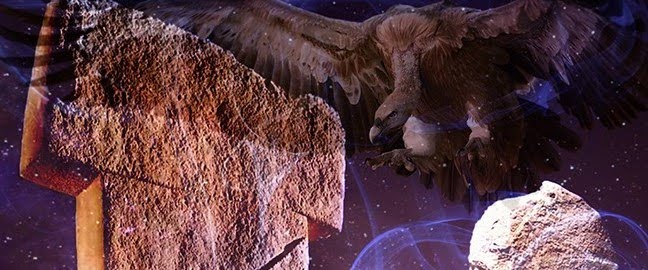The buildings of Göbekli
Tepe.
Enclosure H is one of the
more recently discovered buildings at Göbekli
Tepe. Like the other structures I’ve already discussed, this enclosure
comprises an oval structure with T-shaped pillars in its outer wall and another
two in the centre. It has revealed some of the most intricately decorated
pillars found so far.
Pillar 56, in the outer
wall, has been partly excavated and depicts 55 creatures, the highest number
found on any pillar at Göbekli Tepe. There are so many images
they merge together, with many of them sharing outlines. They include ten
long-legged wading birds; the same number of snakes; a vulture with its wings
spread; several big cats; and a bird of prey with a snake in its claws. A
bucranium (cattle head) is found at its throat.
One of the central
pillars is decorated with a large predatory feline, leaping towards the viewer
just as the foxes are portrayed in Enclosure B. Other pillars in the
outer ring are also decorated with big cats.
Another pillar is
decorated with a large horned aurochs, which appears to be in its death throes.
This pillar seems to have been reused and this is probably not an original
decoration.
A hawk with its prey. (Peter Wallack, Wikicommons).
In Broken Skies,
Enclosure H is the House of Darkness and Light, the fifth building raised by
the Irin shamans. It reflects and teaches the understanding of the ever-turning
cycles of existence: life and death, winter and summer, darkness and light.
These opposites of the pulse of creation exist in perfect balance with each
other. Darkness, literal or metaphorical, is a necessary part of existence. If
the sun was always shining, if nothing that lived ever died, the world would
soon become untenable. The finch falls to the hawk, the deer falls to the wolf,
and both predator and prey are the stronger for it. The weak fall, and the
strong survive. The species as a whole benefits. The dead aurochs and snake in
a bird of prey’s claws represent this brutal balance between predator and prey,
and this is just one example of the philosophy the hunters and shamans of Göbekli Tepe lived by. The vast number of creatures portrayed
on the pillars represents how everything that exists is bound by those same
laws.
A flock of starlings evading a bird of prey. (Mostafameraji, Wikicommons).
Enclosure H is in a different part of the site to the
enclosures already discussed in earlier posts, but it is clear that its pillars were moved and
reconstructed at some point in prehistory. It is possible they were once part
of a building adjacent to the other four, as my story suggests.

































